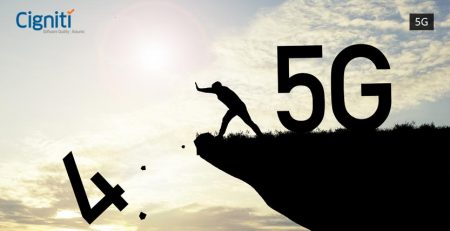Impact of Digital Transformation in the BFS Market
Businesses in the Global Market have always raced to keep up with changing customer expectations, but since the turn of the century, something remarkable has happened. A series of rapid technological advances have contributed to the transformation of customer expectations while simultaneously providing enterprises with the digital tools to create the beguiling experiences that are now needed to satisfy customers.
Today, companies are offering services with unimagined experiences for the customers which were not available five years ago, and which are a part of everyday lives. The race to deliver what ‘on-demand customers’ want has speed up dramatically on an exponential scale.
Businesses operating in Business-to-Consumer (B2C) and Business-to-Business (B2B) model have increased their expectations of product/service quality around the speed, convenience, and ease of use offered by their perceived leaders in customer experience (for example, Uber, Flipkart, Apple, and Amazon).
These expectations now transcend to the traditional industry boundaries with customers expecting similar quality of experiences across the products and services they consume. Similarly, at the same time, the current and upcoming generations of consumers have expectations that are different than the those of the existing.
[Tweet “Per @juniperresearch, by 2017, 1B+ users will be using #mobilebanking. #DigitalTransformation BFS. Are you ready for the impact? Read on.”]
The need to provide a customer experience that competes with both competitors (to make an edge in the same industry) and best-in-class companies (across sectors,) leaves business leaders with plenty of areas to think about. Basically, three areas have been assessed that help retain customers in a digital world:
- From Products and Services to Experiences:
In today’s digital economy, offering just products and services is no longer enough for businesses to succeed. Several companies are using digital technologies to offer customers unique and unforgettable experiences, as enterprises are seeing customer experience emerge as an increasingly important differentiator alongside the quality of their core offering.
- Hyper-personalization:
Customers expect high relevant interactions, with catering to their individual contexts. Digital technology and Modernization approaches are enabling companies to meet these expectations by delivering personalization to large numbers of their customers at low cost and high speed delivery.
However, while recognizing the need to personalize, businesses are struggling to understand how much personalization different customers want, with the answer often clouded by customers’ unwillingness to share personal information with due security and privacy policies.
- Ownership to access:
The concept of access – instead of ownership – has become mainstream. In North America alone, there more than 110 million people now participating in a collaborative economy of digital consumers. Customers are attracted by the convenience of on-demand access, with the prospect of financial savings as well as its potential to improve their quality of life. All the Companies traditionally engaged in ownership models are evaluating opportunities to cater to new expectations of access, before competitors or start-ups sweep in the market/domain.
Industry Market Watch
Banking and Financial products are getting commoditized; customer experience has evolved as a true differentiator rather than a function as it was thought earlier. Banks are increasingly focusing on taking steps to develop deeper relationships with their customers with the prime objective of gaining trust, building engagement, and creating value for consumers to give them a good and long-lasting experience.
Multiple studies indicate that banking firms want to differentiate themselves based on customer experience with online, social media, mobile and cross-channel initiatives getting the top-most priority for customer experience improvement. The crux of the strategy revolves around engaging the customer at his convenience and through his preferred channel/s.
Digital Transformation is the future of Banking Industry, as indicated by the upcoming trends and digital initiatives like Mobile Wallets, P2P transfers, Ping Pay, Omni Channel Banking etc. As per Juniper Research, by 2017, more than 1B mobile subscribers (15% of global mobile subscribers) will be using mobile banking.
Online bill payments now account for 50 percent of all bill payments and mobile banking and consumer usage of tablets are poised for a significant growth. With majority of the US online population accessing their accounts online, online banking is gradually becoming the heart of the customer relationship.
The same is true for mobile banking as well. Mobile banking has seen rapid growth and continues to soar – 56% mobile banking users paid their bill on their mobile phone in 2015 The rise of the digital consumer, rapid expansion of smartphones and their enthusiastic adoption, enhanced mobile usability and richer content are the main drivers of this growth. This has led to a spurt in spends on mobile technology as well.
Digital consumers are also spending more and more time on digital media. The percentage of time spent on the internet has overtaken traditional media such as television, radio, and newspaper. This has led to an increased interest in digital and interactive marketing. Advertisers today spend as much on interactive marketing as they do on television advertising.
Investment in search marketing, display advertising, e-mail marketing, mobile marketing, and social media will near $77 billion and represent 26% of all advertising, as interactive channels gain legitimacy in the marketing mix.
Major Drivers for the Transformation are as below:
- Digital Consumer/Customers
- Digital Devices and many more
Digital Consumers
- Consumers of the Banking and Financial Services (BFS) sector across the world have been going more and more digital due to the ever-increasing convenience factor, exploding technological advancements, proliferation of mobile devices, and growing adoption of the social community lifestyle.
- The digital consumer today is ‘omnipresent’: in touch with banking services from anywhere through advanced IT channels, is ‘always online’, and expects 24X7 availability and responsiveness from the bank.
- The digital consumer is ’networking globally’ with potential and fellow consumers of the bank.
- A digital consumer expects a rich, engaging, consistent and seamless experience across the touch points with best-fit, best-in-time, and best-in-place offerings and services.
Digital Devices
- Digital Devices are metamorphosing to support rich multi-media handling, secure information channelling, and powerful computing capability.
- Social media sites are opening to interface with banking channel applications and are slowly becoming legitimate digital banking channels in themselves.
- The banking industry, which has traditionally relied on well-defined means of customer engagement, is facing its steepest challenge in over a generation.
- Banks need to evolve from being ‘Custodian of Transactions’ to ‘Custodian of Customers’.
- Although banks have started to address this need, they still have a long way to go to comprehensively exploit the digital consumer phenomenon.
Digital Transformation Concerns and Challenges BFS sectors face
Banks are also faced with many questions on the approach and strategy for digitization.
- They need a mechanism to understand and analyze consumer behaviour across channels, listen to uninhibited feedback, tap on to innovative product ideas (crowd-sourcing) and finally promote new products and services.
- At the same time, Banks need to drive adoption of established self-servicing channels further.
- They need Quality and Real-time based information systems and tools to spread their businesses and markets areas.
A holistic, business-sponsored, digital strategy is becoming a must for banks. While innovations continue to happen on the consumer-side technology landscape, foundational capabilities require strengthening the channels and customer management areas.
[Tweet “are you aware of the role #SecurityTesting #PerformanceTesting play in the new Digital Banking and Finance world? Read on to know more.”]
To meet this need, both mainstream and niche technology vendors are expanding their solutions and services. Banks need to make diligent buy v/s build decisions keeping cost and time to market on one side and offering differentiated consumer experiences on the other. Carefully chosen vendor strategy plays an important role in achieving the digital consumer vision.
Solutions
Cigniti with its acclaimed experience in the Banking space has well tested tools and accelerators that can positively impact the effort involved and in the areas of performance and security testing to address the specific challenges faced by clients.
We provide services in the areas of reusable artefacts, frameworks, and models from manual to digital Quality covering the Security and performance attributes in a loop to provide long and maintainable solution to the clients.
- Security Testing: Security Testing at Cigniti is one of the critical parts of development strategy and an IP for the Organization. This has been effectively addressed by the latest standards and Testing methodologies.The Security Testing of Enterprise applications are catered to diverse business needs and are in synch with the Digital world, and spreading across the industries. This Testing Methodology helps in finding the uncovered vulnerabilities within the application and prevents unpredictable risks. The analyser and software code will help organizations improve the quality benchmark of their testing standards.
- Performance Testing: Performance Testing provides a cutting-edge service to the IT-Quality Market. A part of testing services covers client-server, mobile, cloud data-based, high volume transaction system, and high complex applications. The Performance Center of Excellence (PCoE) provides end-to-end performance testing solution to clients. This covers capacity planning, baseline test, load, stress, endurance and benchmarking, production monitoring, and consulting.
Conclusion
The Demonetization Act on Nov, 8, 2016. has brought a great revolution in the Indian Financial and Banking system with the collaboration of the IT-Industry. This has sown a seed for Digital Transformation and brought up a New Market as well as laid a new path for the Banking and Finance Ecosystem. In fact, this Act created ripples in the Global Banking and Financial Market with strict, hard laws, policies, and constraints in the limits of services usage.
Today’s digital BFS marketplace is a high impact business place. It has major implications for the BFS industry and is creating an awareness that banks should address the digital transformation process from strategy, roadmap, governance, and vendor selection perspectives for a successful currency domain market.
IT has become a necessity and for all the banking and financial institutes to sustain in the market and to serve better to their customers, they need to invest in IT. There is long way to go in the making of a cashless banking ecosystem that has a strong focus on customer focus and revenue growth.
There is a lot left to explore in the areas of Internet Banking, Mobile Banking, Digital Banking, and more.




Leave a Reply